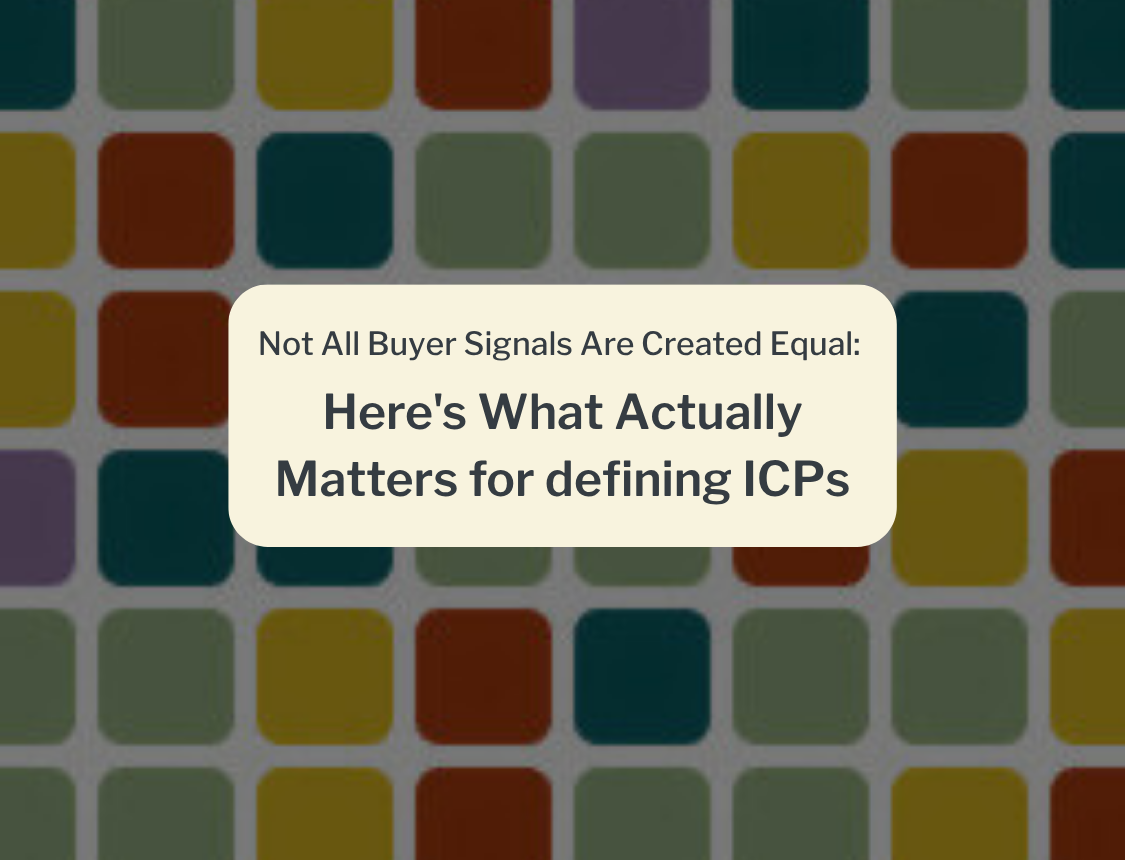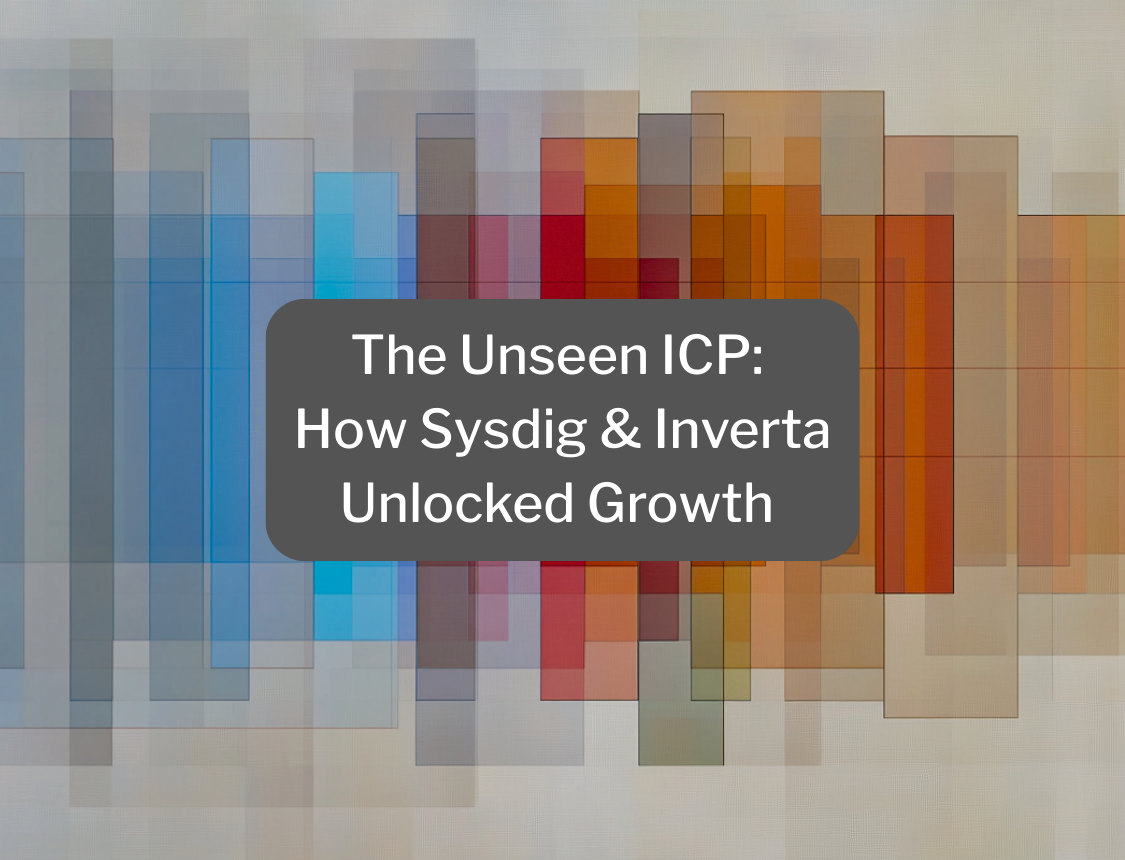
Not All Buyer Signals Are Created Equal: Here's What Actually Matters for defining ICPs

Not All Buyer Signals Are Created Equal: Here's What Actually Matters for defining ICPs
The go-to-market world has made huge progress in how we think about Ideal Customer Profiles (ICPs). Thanks to frameworks from GTM Partners and others, we now have a shared language around firmographics, technographics, and buying signals. Ten years ago, many companies defined their ICP as "anyone with a budget" or “enterprise, mid-market, and SMB.” We've come a long way since then.
But here’s the uncomfortable truth: most ICP frameworks still blur the lines between three very different things—segment attributes, sales qualification criteria, and buying signals. There’s also a misperception that some yet-to-be-discovered attribute exists out there in the ether that will provide the silver bullet. The reality is that just blending these signals together to define your ICP sounds impressive but doesn’t drive results and or create trust across your GTM team.
Let’s break that down—and show you a clearer, more actionable way forward.
The Problem with Traditional ICP Thinking
Most ICP frameworks pull in everything from company size to intent data to team structure. The desire is right, but the execution falls short—because these signals don’t carry equal weight and some have zero reason to be baked into an ICP analysis. Some attributes identify high-value segments. Others are sales stage clues. And some simply tell you when to reach out.
When you treat them all the same, three things happen:
- You target the wrong accounts.
- You waste marketing spend.
- You create friction between Sales and Marketing.
Let’s fix that.
What Actually Defines an ICP Segment
An ICP isn’t just a set of filters. It’s a segment of accounts that:
- Share common, targetable attributes
- Demonstrate strong product-market fit (PMF) as defined by revenue metrics (e.g., LTV, NRR, Use Case, etc.)
- Show message-market fit (MMF) as defined by sales metrics (e.g., ACV, win-rates, and deal velocity)
Here’s how we break that down at AlignICP:
Product-Market Fit Metrics: Does Your Product Work for Them?
- LTV (Lifetime Value)
- NRR (Net Revenue Retention)
- Use Case
These are outcome-based signals. If a segment has a 45% win rate, $200K ACV, and 120% NRR—double down. If it’s 15%, $50K, and high churn—it’s not your ICP.
Message-Market Fit Metrics: Does Your Message Resonate?
- Win Rate
- ACV (Average Contract Value)
- Sales Velocity
When MMF is strong, deals move fast, champions show up, and Sales doesn’t have to “educate the market.”
Targetable, Fact-Based Account Attributes
- Firmographics (industry/sub-industry, revenue band, headcount, growth)
- Technographics (stack compatibility, integration needs)
- Geographic (regulatory requirements, market considerations)
These are the ingredients that make segmentation repeatable and scalable.
What Doesn't Belong in Your ICP Definition
Many frameworks still bake in signals that are critical for sales execution—but don’t belong in your ICP:
Sales Qualification Signals:
- Budget ownership & line item presence
- Trigger event and/or motivating factors
- Presence of a champion
- Decision-maker access
These help sales reps qualify specific deals. They don’t define segments.
Buying Signals:
- Intent data
- Recent hires
- Funding rounds or transactions
- New tech installs
These tell you when to engage, not who your best-fit customers are.
The AlignICP Approach: Data First, Assumptions Last
We help GTM teams build ICP segments using the metrics that matter:
- Start with customer performance data
- Generate win rates, ACV, LTV, NRR by segment
- Run regression to find attribute correlations
- Let the data tell you which traits matter most
- Define segment-level ICPs
- Don’t stop at one ICP—build clusters that outperform your baseline
- Layer in qualification and intent for execution
- Prioritize within your ICP, not instead of it
This creates a full-funnel view—where Marketing knows who to target, Sales knows why they’ll win, and Finance sees why it all adds up.
Why It Works
- Sales & Marketing alignment is built-in. You’re targeting what actually converts. You have the key sales and revenue data that defines your ICP that sales and leadership will trust.
- Marketing ROI is clear. You can show the CFO which segments deliver pipeline and revenue and move away from being viewed as a tactical lead gen source to a strategic GTM strategist.
- Product & CS stay in sync. Everyone focuses on the customers who stick and grow.
- Your TAL is no longer a guess. It’s built from proven success patterns that cross-functional teams can inspect and trust.
Respect the foundation. Evolve the framework.
The current generation of ICP thinking gave us a great starting point. But the next generation is data-defined, segment-specific, and performance-backed.
That’s what actually matters.
Ready to rethink your ICPs with real data?
Check out our Definitive Guide to Data-Driven ICPs or browse the AlignICP blog for more.
https://www.alignicp.com/definitive-guide-for-data-driven-icps-for-predictable-saas-growth
.svg)

